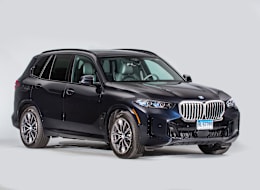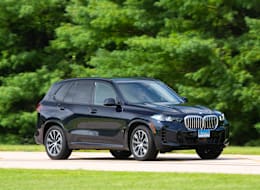The BMW X5 plug-in hybrid electric vehicle (PHEV) combines high levels of comfort, a hint of sportiness, and a dash of efficiency. The X5 PHEV model received a number of significant updates for 2024, including a larger battery, a more robust electric-only driving range, and increased power. As a result, the X5 xDrive50e adds more luster to the things we’ve always loved about BMW’s midsized luxury SUV, such as its comfortable, quiet, and impeccably finished interior, ultra-smooth powertrain, surprisingly athletic handling, and steady and composed ride.
Simply put, the X5 remains among the best SUVs we’ve tested.
For consumers new to PHEVs, these are hybrids with larger batteries that can be plugged into a standard 120-volt household outlet or a 240-volt EV charger. This gives the vehicle a dedicated electric-only driving range (typically for about 20 to 40 miles, depending on the model) for commuting and running errands, which is something that regular hybrids can’t do. When the battery is drained, the vehicle switches to regular hybrid operation. This also means that, unlike a full battery-electric vehicle, there is no need to find a public charger on a long trip because the gas engine takes over once the electric range is used up.
For buyers who are nervous about going all-in for an EV, a plug-in hybrid could be a logical and cautious step toward electrification. PHEVs make especially good sense if you have a short commute to work, rarely drive long distances, and have the ability and willingness to plug in your vehicle at home to charge overnight—it’s bound to save you money at the gas pump. Plus, unlike regular hybrids, a PHEV may be eligible for federal tax credits. Considering that the average American drives less than 40 miles per day, this means many people will be able to do most of their daily commute on electric power while reserving the gas engine for longer trips.
The X5 xDrive50e’s powertrain combines a 3.0-liter, twin-turbocharged inline six-cylinder engine with an electric drive, an eight-speed automatic transmission, and standard all-wheel drive. Given that the total hybrid system output is nearly 500 hp, straightline thrust is abundant under any circumstance. It sprinted from 0 to 60 mph in a blistering 4.4 seconds.
The X5 xDrive50e has an EPA-rated 39 miles of all-electric range, which puts it toward the upper echelon of PHEVs. It takes 3.5 hours to charge the X5’s 25.7-kilowatt-hour battery using a 240-volt (Level 2) connection. On a regular 120-volt household outlet, it took an interminable 30 hours to recharge. Given the X5’s large battery, we think a dedicated 240-volt EV wall charger would be a wise investment for your garage.
Once the X5 PHEV’s batteries are fully juiced, drivers can lock-in the electric mode and drive it like an EV, if they’d like. Alternatively, they can reserve the electric portion for later, say if they’re anticipating some stop-and-go city driving after a highway cruise. (It’s more efficient to use electric power at low speeds rather than on the highway.)
When the battery gets depleted, the X5 PHEV transitions to regular hybrid operation, and in that mode it managed 21 mpg in our testing. That’s notably less than the 23 mpg overall of the last nonhybrid turbo-six X5 we tested, a result of the extra 800 pounds the PHEV version carries thanks to its heavy battery. This just further hits home the importance of plugging in your X5 PHEV as often as possible in order to reap the maximum efficiency benefits of the electric miles.
The X5 has always delivered a composed ride, but with the PHEV’s standard air suspension and extra weight, the ride has gotten even better. Bumps are shrugged off as if without a care, and the X5’s body stays settled and composed without the amount of side-to-side occupant-jostling that many SUVs suffer from. Handling is engaging, with impressive cornering capabilities for such a large and heavy vehicle. It remained secure and responsive when pushed to its limits around our track, too. Braking performance also proved superb, with a competitively short stopping distance on our dry surface.
The cabin is whisper-quiet—whether the X5 is being moved along by battery power or gas—further imparting a feeling of luxury. The interior is richly trimmed in leather, wood, chrome, and high-quality plastics, with every touch point well-padded. The optional heated front door- and center armrests made cold mornings that much more bearable. There are also plenty of small-item storage spaces, including huge door pockets.
The front seats are supportive and provide a wide variety of adjustments, which makes them perfect for all-day drives. The rear seat has plenty of headroom and good foot space underneath the front seats, but the bottom cushion’s rather low position results in less-than-ideal underleg support.
Open the two-piece tailgate and there’s a nicely finished cargo area. The large top door swings up, and the small bottom gate drops down to ease loading. One button conveniently power-closes both.
But we can’t gloss over the X5’s biggest flaw: The complicated and convoluted iDrive infotainment system. It has a steep learning curve and it can be thoroughly frustrating to use. We were constantly annoyed by the fact that most of the climate controls no longer have physical knobs or buttons, and instead force you to venture into the touchscreen to make even simple adjustments. On a positive note, the optional head-up display (HUD) is excellent and allows you to seamlessly interact with the radio and phone through steering wheel buttons.
Standard active safety systems and driver assistance features on the X5 PHEV include automatic emergency braking with pedestrian, cyclist, and motorcycle detection, plus automatic emergency braking that operates at highway speeds, blind spot warning, rear cross traffic warning, lane departure warning, and lane keeping assistance. The X5’s optional “Driving Assistance Professional” package brings the ability to simultaneously use adaptive cruise control and lane centering assistance, and includes an automatic lane-change function.


























